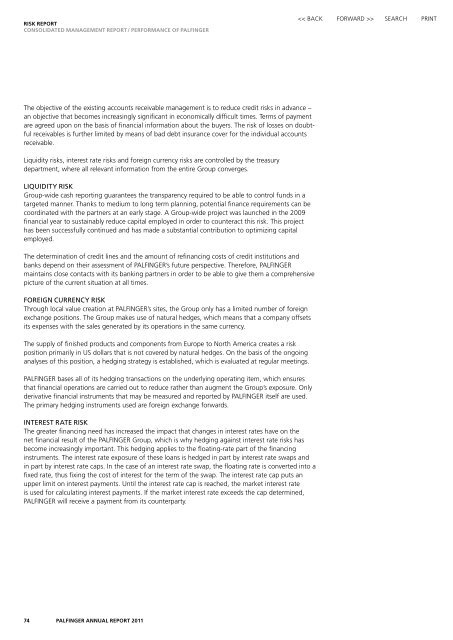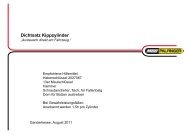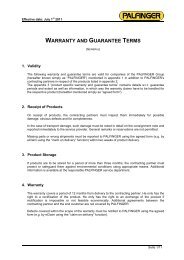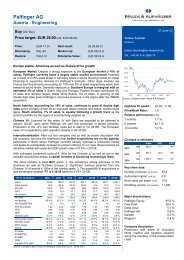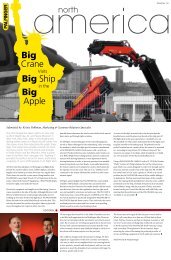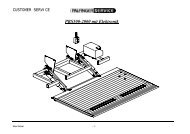palfinger at a glance
palfinger at a glance
palfinger at a glance
Create successful ePaper yourself
Turn your PDF publications into a flip-book with our unique Google optimized e-Paper software.
Risk Report<br />
conSoliD<strong>at</strong>eD MANAGEMENT REPORT / PERFORMANCE OF PALFINGER<br />
> search Print<br />
The objective of the existing accounts receivable management is to reduce credit risks in advance –<br />
an objective th<strong>at</strong> becomes increasingly significant in economically difficult times. Terms of payment<br />
are agreed upon on the basis of financial inform<strong>at</strong>ion about the buyers. The risk of losses on doubtful<br />
receivables is further limited by means of bad debt insurance cover for the individual accounts<br />
receivable.<br />
Liquidity risks, interest r<strong>at</strong>e risks and foreign currency risks are controlled by the treasury<br />
department, where all relevant inform<strong>at</strong>ion from the entire Group converges.<br />
Liquidity risk<br />
Group-wide cash reporting guarantees the transparency required to be able to control funds in a<br />
targeted manner. Thanks to medium to long term planning, potential finance requirements can be<br />
coordin<strong>at</strong>ed with the partners <strong>at</strong> an early stage. A Group-wide project was launched in the 2009<br />
financial year to sustainably reduce capital employed in order to counteract this risk. This project<br />
has been successfully continued and has made a substantial contribution to optimizing capital<br />
employed.<br />
The determin<strong>at</strong>ion of credit lines and the amount of refinancing costs of credit institutions and<br />
banks depend on their assessment of PALFINGER’s future perspective. Therefore, PALFINGER<br />
maintains close contacts with its banking partners in order to be able to give them a comprehensive<br />
picture of the current situ<strong>at</strong>ion <strong>at</strong> all times.<br />
Foreign currency risk<br />
Through local value cre<strong>at</strong>ion <strong>at</strong> PALFINGER’s sites, the Group only has a limited number of foreign<br />
exchange positions. The Group makes use of n<strong>at</strong>ural hedges, which means th<strong>at</strong> a company offsets<br />
its expenses with the sales gener<strong>at</strong>ed by its oper<strong>at</strong>ions in the same currency.<br />
The supply of finished products and components from Europe to North America cre<strong>at</strong>es a risk<br />
position primarily in US dollars th<strong>at</strong> is not covered by n<strong>at</strong>ural hedges. On the basis of the ongoing<br />
analyses of this position, a hedging str<strong>at</strong>egy is established, which is evalu<strong>at</strong>ed <strong>at</strong> regular meetings.<br />
PALFINGER bases all of its hedging transactions on the underlying oper<strong>at</strong>ing item, which ensures<br />
th<strong>at</strong> financial oper<strong>at</strong>ions are carried out to reduce r<strong>at</strong>her than augment the Group’s exposure. Only<br />
deriv<strong>at</strong>ive financial instruments th<strong>at</strong> may be measured and reported by PALFINGER itself are used.<br />
The primary hedging instruments used are foreign exchange forwards.<br />
Interest r<strong>at</strong>e risk<br />
The gre<strong>at</strong>er financing need has increased the impact th<strong>at</strong> changes in interest r<strong>at</strong>es have on the<br />
net financial result of the PALFINGER Group, which is why hedging against interest r<strong>at</strong>e risks has<br />
become increasingly important. This hedging applies to the flo<strong>at</strong>ing-r<strong>at</strong>e part of the financing<br />
instruments. The interest r<strong>at</strong>e exposure of these loans is hedged in part by interest r<strong>at</strong>e swaps and<br />
in part by interest r<strong>at</strong>e caps. In the case of an interest r<strong>at</strong>e swap, the flo<strong>at</strong>ing r<strong>at</strong>e is converted into a<br />
fixed r<strong>at</strong>e, thus fixing the cost of interest for the term of the swap. The interest r<strong>at</strong>e cap puts an<br />
upper limit on interest payments. Until the interest r<strong>at</strong>e cap is reached, the market interest r<strong>at</strong>e<br />
is used for calcul<strong>at</strong>ing interest payments. If the market interest r<strong>at</strong>e exceeds the cap determined,<br />
PALFINGER will receive a payment from its counterparty.<br />
74 <strong>palfinger</strong> Annual Report 2011


